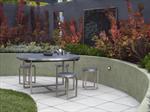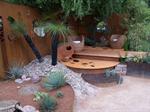
How to Use your Backyard Better
Everyone would love to have a better backyard. It doesn't matter how much you manage to achieve, there always seems to be something more to do in the backyard, and the "grass always looks greener on the other side of the fence."
This magazine shows you how to make the grass greener on your side of the fence. It is jam packed full of ideas on how to make your yard look better and be more useable.
Try thinking of the backyard as your families playground. This is the first step towards a better backyard. You need to understand what is important to your family, and how your family likes to play. For some people, there is nothing better than a backyard bbq or entertaining around a pool, while others like to use the backyard for their hobbies (whether that be gardening, tinkering with cars or playing basketball).
If you have children, the yard is an important place for them to play. If you have animals, the backyard is normally their home also. In these situations, you may decide to fence off areas for the children to build cubbies or as an exercise area for your dog, unless you don't mind the threat of constant damage to plants and lawn. Think carefully about the type of pets you have and how they fit into your vision of the backyard. Small dogs (e.g. Toy poodles) do very little damage, but large dogs in a small yard are a constant maintenance problem. Cats jump fences and chase birds out of the garden, but on the positive side, they also keep mice and rats away.
If you are retired, gardening might be a serious hobby, and the routine maintenance may keep you active, but remember, as you get older, things will become more difficult to do, and if you plan to continue living in your home, the garden needs to be able to evolve into something easily looked after.

BETTER BACKYARD IDEAS
Here are just a few things you might do to improve your backyard:
- Build paved terraces or timber verandahs to sit or entertain on. Hard surfaced areas dry out faster than grass and provide an even, solid base to walk or work on.
- Cover an area with shade cloth for coolness and protection from UV radiation.
- In cool climates, cover an area with one of the clear sheeting materials available, such as fibreglass, or polycarbonate, for protection from rain and cold.
 Build a fernery to make the garden seem cooler.
Build a fernery to make the garden seem cooler.- Build a swimming pool or spa
- Install an outdoor room to escape too, or as an entertainment area (This might be anything from an inexpensive shed to an elaborate Victorian Conservatory). Use it for your hobby, as a sewing room, a reading room, a music room, a workshop, a table tennis room, etc).
- Install a pond, fountain or waterfall
- Grow fish in a pond or swimming pool
- Use a statue, sundial or weather vane as a focal point.
- Grow a hedge along a path or fenceline.
- Build a fence or wall to divide off a section of the yard
- Build a vegetable garden
- Install a hydroponic garden
- Install a removable or fold up washing line to provide more room.
- Build a small putting green or mini golf course.
- Build a sand pit for the children or grand children (Keep it covered with fine wire mesh to keep animals and lawn clippings out).
- Build a Greenhouse or shade house
- Get a seat
- Get an outdoor setting (Table and chairs)
 Make a path
Make a path- Build or buy a bbq
- Convert lawn areas to mulched garden bed
- Convert garden bed areas to lawn
- Convert lawn areas to hard wearing concrete or paving
- Attach trellis to the top of a fence to improve privacy
- Grow a climber on a wire mesh fence to create a more solid barrier.
- Pave between a swimming pool and the house to make it less slippery.
- Slippery areas where algae or moss grows can be aerated with a fork, or sprayed with iron sulphate (ie. moss killer). Trees and shrubs can be cut back to improve light and ventilation to help these areas dry out.
- If tree roots are coming to the surface of a lawn, or cracking paths, try deep watering the tree during dry weather to keep the roots deeper (ie. Drill a 1m deep hole with an auger, insert a PVC pipe and water with a slow dripping hose into the pipe for 24hrs every month or two).
More from ACS
Ebook - Relationships between PLAY and the ENVIRONMENT and how to best utilise this in designing a play area.
View eBook